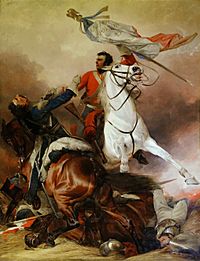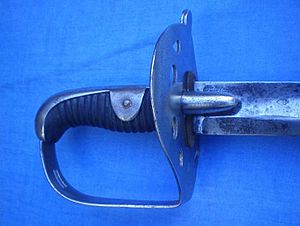Pattern 1796 heavy cavalry sword facts for kids
Quick facts for kids Pattern 1796 heavy cavalry sword |
|
|---|---|

Sergeant Charles Ewart of the Scots Greys at Waterloo, wielding the 1796 pattern sword as he captures the eagle of the 45e Ligne
|
|
| Production history | |
| Designed | 1796 |
| Manufacturer | Various |
| Produced | 1796-1821 |
| Specifications | |
| Length | Blade: 35ins (88.9cm) |
|
|
|
| Blade type | Straight, single fuller, hatchet point (often modified). |
| Hilt type | Disc-guard and single knucklebow. |
| Scabbard/sheath | Iron, wood liners, 2 loose suspension rings. |
The Pattern 1796 heavy cavalry sword was a powerful sword used by British heavy cavalry soldiers. These soldiers rode big horses and were part of groups like the Lifeguards and Dragoons. This sword was very important during the Revolutionary and Napoleonic Wars. It was especially famous for its use in big battles like Salamanca and Waterloo. Some cavalry in Sweden and Portugal also used this type of sword.
Contents
History of the Sword
The British 1796 Heavy Cavalry Trooper's Sword was actually a copy of an Austrian sword. This Austrian sword, called the pallasch, was used by heavy cavalry since 1769.
A British cavalry officer named John Le Marchant saw the Austrian sword. He was fighting in the Low Countries from 1793 to 1795. He drew many pictures of Austrian cavalry gear.
Le Marchant had designed his own curved sword. He wanted all cavalry to use it. But military leaders decided that heavy cavalry needed a straight sword. So, Le Marchant likely suggested the Austrian sword as a good model.
How the Sword Was Designed
The Trooper's Sword
The 1796 heavy cavalry sword is a type of sword called a backsword. This means it has a straight blade with only one sharp edge. The other side of the blade is thicker. This makes the sword stronger.
The blade was about 35 inches (890 mm) long. It had a single wide groove, called a fuller, on each side. The handle was made of wood, often covered in leather. The metal part at the back of the handle was strongly attached to the blade.
The sword's guard had a disc shape with holes. It also had a single knuckle guard to protect the hand. Two small metal pieces, called langets, stuck out from the front of the guard. These helped hold the sword in its scabbard.
Soldiers often changed their swords. They sometimes removed the langets. They also ground down the left side of the guard. This made the sword more comfortable to wear. It also stopped it from wearing out uniforms.
The sword's tip was originally shaped like a 'hatchet point'. This was a curved, diagonal edge. But many soldiers changed it to a 'spear point'. This was a more common, symmetrical tip. They did this to make the sword better for thrusting.
Many swords were also made shorter, around 33-inch (840 mm) long. They came with shorter scabbards too. The sword was carried in a metal scabbard with wood inside. It hung from the waist using two rings.
Household Cavalry Swords
Some special versions of the sword were made for the Household cavalry. These regiments included the Life Guards and Horse Guards. These swords had the same blade as the regular trooper's sword.
However, their hilts (handles) were different. They had a bowl-shaped guard, like the officers' swords. Life Guards had brass hilts and scabbards. Horse Guards had iron hilts and scabbards. These were likely used for ceremonial duties at home.
These scabbards usually did not have hanging rings. Instead, they had a button or slide. This was for attaching the sword to a 'frog', which is a type of belt attachment. When on active duty, these regiments used the standard trooper's swords.
Officer's Swords
Officers had different swords. Their everyday sword, called an "undress sword," had a blade like the trooper's sword. Many officers' blades were decorated with etchings or blue and gold designs.
The guard of the officer's sword was very different. It was bowl-shaped and had fancy cut-out designs. This hilt is sometimes called a 'ladder hilt'.
Officers also had a "dress sword" for formal occasions. This sword was smaller and lighter. It had a knuckle guard and a fancy metal guard. Its blade was much shorter and narrower. It was usually double-edged. This dress sword often had a leather scabbard with fancy metal parts. Some officers might have used their dress swords in battle.
How the Sword Was Used
The trooper's sword and the officer's undress sword were made for cutting. They had a wide, heavy blade. People said they were not good for fancy sword fighting.
But this was also why they were respected. Most cavalry soldiers used these swords like heavy clubs. They even used the guards like knuckle dusters. The 1796 sword was much better for this kind of rough fighting than other swords.
Sergeant Charles Ewart of the Scots Greys described the sword's power. He used it to capture an Imperial Eagle at the Battle of Waterloo:
"I took the eagle off the enemy; he and I had a hard fight for it. He tried to stab me, but I blocked it and cut him down through the head. Then a lancer came at me. I pushed his lance away and cut him through the chin and teeth. Next, a foot soldier shot at me, then attacked me with his bayonet. I was lucky to block that too, and I cut him down through the head. That's how the fight ended."
In Stories
The fictional character often linked to the 1796 Heavy Cavalry Sword is Richard Sharpe. He is a Rifle officer in Bernard Cornwell's books about the Napoleonic Wars.
See also
Images for kids




